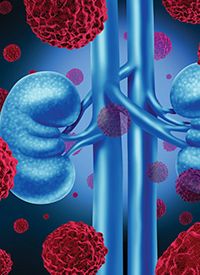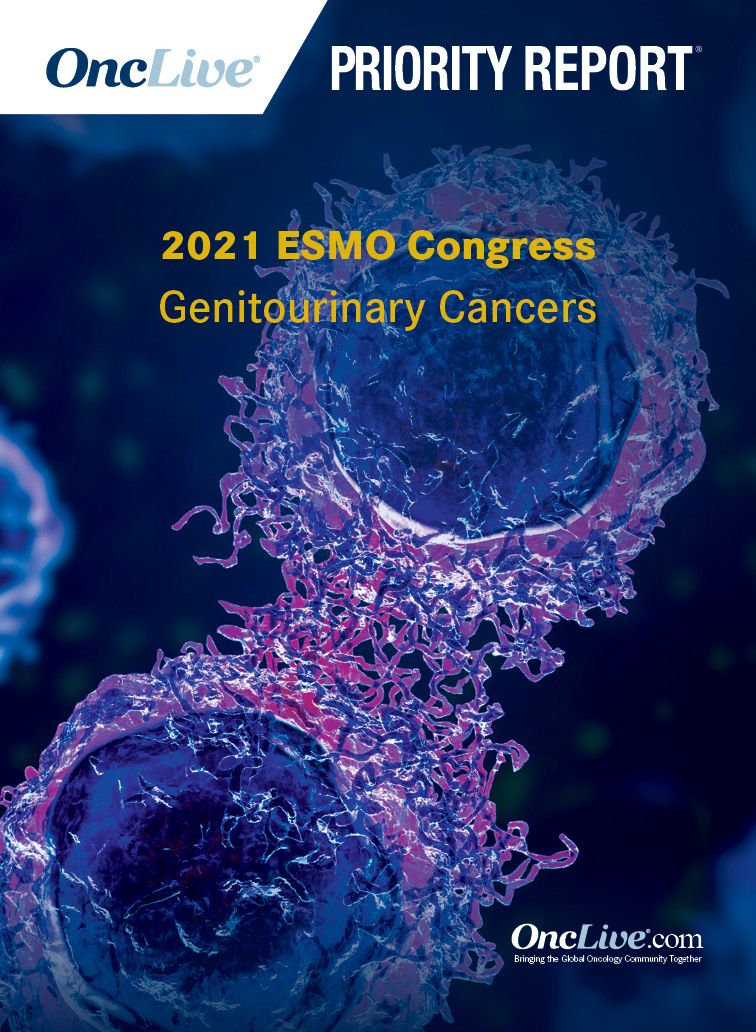Publication
Article
Supplements and Featured Publications
Pembrolizumab/Axitinib Combo Demonstrates Long-Term OS Benefit in Clear Cell RCC
Author(s):
Patients with clear cell renal cell carcinoma who received the combination of pembrolizumab and axitinib over sunitinib showed a benefit in adjusted overall survival and type and timing of subsequent therapy in a second interim analysis of the phase 3 KEYNOTE-426 study.

Patients with clear cell renal cell carcinoma who received the combination of pembrolizumab (Keytruda) and axitinib (Inlyta) over sunitinib (Sutent) showed a benefit in adjusted overall survival and type and timing of subsequent therapy in a second interim analysis of the phase 3 KEYNOTE-426 study (NCT02853331).
Rustem Gafanov, MD, a principal investigator at the Russian Scientific Center of Roentgenoradiology, Moscow, Russian Federation, and colleagues, reported the findings during the 2021 European Society of Medical Oncology Congress.1
Using a 2-stage estimation (TSE) model, investigators determined the effect, called the acceleration factor, of subsequent anticancer therapy for patients in KEYNOTE-426 (stage 1). In stage 2, survival time was determined after patients received the combination treatment of pembrolizumab and axitinib vs sunitinib. Survival time was adjusted multiplicatively by the acceleration factor that was determined in stage 1 of the trial. The investigators report that patients were assumed to be at a similar stage of disease in stage 1, ie, TSE model without recensoring.
At the data cutoff of January 21, 2021, 861 patients were randomly assigned to receive either pembrolizumab plus axitinib or sunitinib. There were 432 patients assigned to the combination arm and 429 were treated; there were 429 patients assigned to the monotherapy arm, with 425 patients receiving treatment.
In the combination arm, 18 (4.2%) patients completed treatment, 62 (14.5%) patients had ongoing treatment, and 349 (81.4%) patients discontinued. In the monotherapy arm, 40 (90.4%) patients had ongoing treatment and 385 (90.6%) had discontinued.
At the median follow-up of 42.8 months (range, 35.6-50.6), 204 patients in the combination arm received subsequent treatment with 3 who completed the regimen; there were 201 patients who discontinued treatment. Among those who discontinued, 150 patients demonstrated radiographic progressive disease (PD), 31 reported adverse events (AEs), and 8 patients decided to discontinue. There were 225 patients who did not receive subsequent treatment, with 15 completing the regimen, 62 had ongoing treatment, and 148 patients who discontinued. Reasons for discontinuing included radiographic PD (n = 64), AEs (n = 52), and 11 patients decided to discontinue.
In the monotherapy arm, 281 patients received subsequent treatment. Among those, 280 discontinued treatment. There were 192 patients who discontinued because of radiographic PD, 48 patients discontinued due to AEs, and 14 patients decided to discontinue. In this arm, 145 patients did not receive subsequent treatment, with 40 patients receiving ongoing treatment and 105 patients who discontinued. Reasons for discontinuing included radiographic PD (n = 51), AEs (n = 30), and patient’s decision (n = 11).
In the combination arm, median OS was 45.7 months (95% CI, 43.6-not reached) and in the monotherapy arm, median OS was 40.1 months (95% CI, 34.3-44.2). Patients in the combination arm had a 27% lower risk of death compared with the monotherapy arm (HR, 0.73; 95% CI, 0.60-0.88). Median PFS was 15.7 months in the combination arm (95% CI, 13.6-20.2) compared with 11.1 months in the monotherapy arm (95% CI, 8.9-12.5). Patients in the combination arm had a 32% lower risk of death (HR, 0.68; 95% CI, 0.58-0.80). Patients in the combination arm had an overall response rate (ORR) of 60.4% (95% CI, 55.6%-65.1%) compared with the monotherapy arm of 39.6% (95% CI, 35.0%-44.4%).
Baseline characteristics were similar for both arms. Average age was 61 years and 71.6% of participants were male in the combination arm (n = 204) compared with 77.6% in the monotherapy arm (n = 281). Regarding PD-L1 status, combined positive score (CPS) greater than 1 was 58.3% in the combination arm vs 61.6% in the monotherapy arm. CPS less than 1 was 38.7% in the combination arm vs 34.2% in the monotherapy arm. Overall, 47.6% of patients who received the combination treatment went on to receive subsequent systemic treatment of any type compared with 66.1% of patients who received monotherapy.
Among patients who received subsequent anticancer therapy with a PD-1/PD-L1 inhibitor, 21.6% were treated with the combination (N = 432) and 74.4% were treated with monotherapy (N = 429). In the combination arm, 88.2% of patients received any VEGF/VEGFR inhibitor compared with 68.7% in the monotherapy arm. Treatment with an agent other than PD-1/PD-L1 or VEGF/VEGFR inhibitors included everolimus (Afinitor; combination arm, 26.0% vs monotherapy arm, 13.%), ipilimumab (Yervoy; 3.9% vs 7.5%, respectively), and other (7.4% vs 5.3%).
In all patients who received subsequent therapy, median time to first subsequent therapy was 15.4 months (range, 0.8-44.9) in the combination arm compared with a median of 11.6 months (range, 0.2-45.3) in the monotherapy arm. Time to receive any PD-1/PD-L1 checkpoint inhibitor was a median of 25.2 months (range, 1.6-43.7) in the combination arm compared with a median of 14.0 months (range, 0.5-45.6) in the monotherapy arm. Time to receive any VEGF/VEGFR inhibitor was a median of 15.3 months (range, 0.8-44.9) in the combination arm compared with 14.6 months (range, 0.2-44.0) in the monotherapy arm. Time to any other treatment was 19.6 months (range, 3.5-46.5) in the combination arm compared with 16.0 months (range, 1.4-38.9) in the monotherapy arm.
The investigators concluded that patients in the combination arm received less frequent PD-1/PD-L1 inhibitor therapy vs the patients in the monotherapy arm. Patients who received the combination received more frequent VEGF/VEGFR therapy vs patients in the monotherapy arm. They noted that long-term OS with adjusted analysis was similar to the first interim analysis,2 in which few patients received subsequent therapy. These results, along with the first interim analysis, continue to support the use of pembrolizumab/axitinib over sunitinib in the first-line setting.
References
- Gafanov R, Powles TB, Bedke J, et al. Subsequent therapy following pembrolizumab + axitinib or sunitinib treatment for advanced renal cell carcinoma (RCC) in the phase III KEYNOTE-426 study. Presented at: 2021 European Society of Medical Oncology. September 16-21, 2021. Abstract 669P. Accessed September 16, 2021. https://bit.ly/2XAezlA
- Rini BI, Plimack ER, Stus V, et al. Pembrolizumab plus axitinib versus sunitinib for advanced renal-cell carcinoma. N Engl J Med. 2019;380(12):1116-1127. doi:10.1056/NEJMoa1816714










